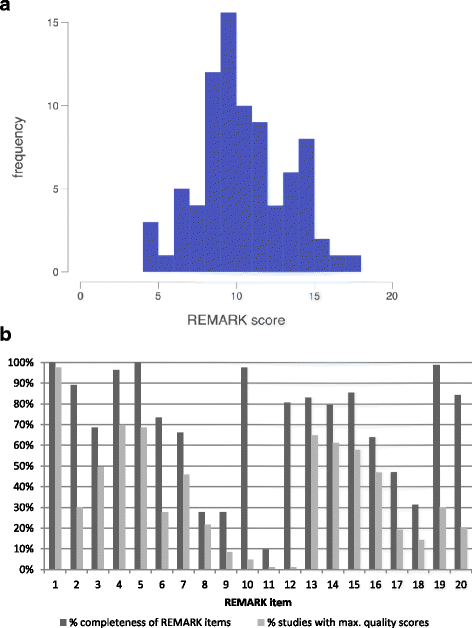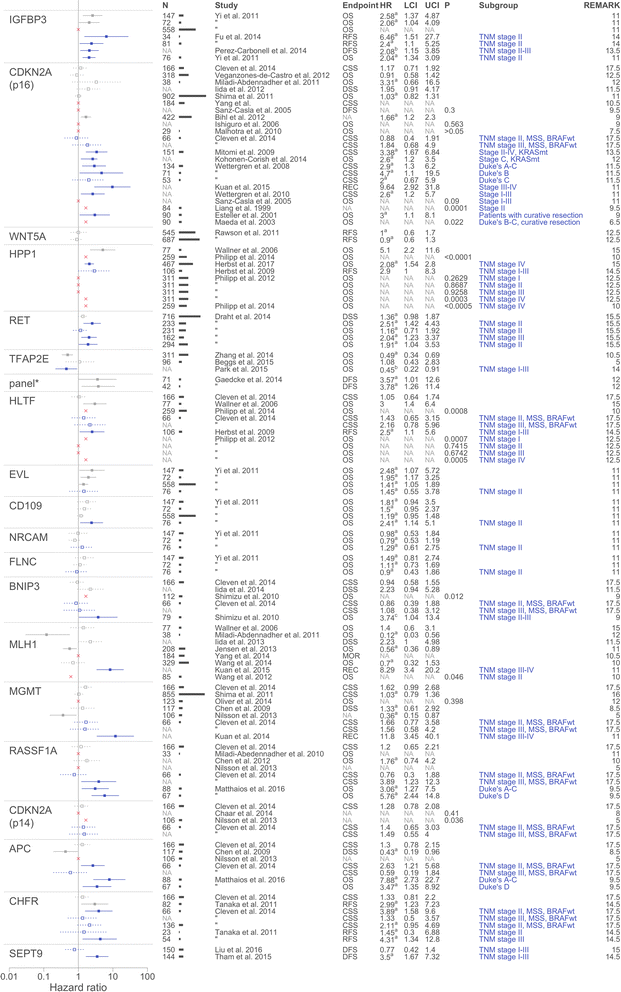Prognostic DNA methylation markers for sporadic colorectal cancer: a systematic review
- PMID: 29564023
- PMCID: PMC5851322
- DOI: 10.1186/s13148-018-0461-8
Prognostic DNA methylation markers for sporadic colorectal cancer: a systematic review
Abstract
Background: Biomarkers that can predict the prognosis of colorectal cancer (CRC) patients and that can stratify high-risk early stage patients from low-risk early stage patients are urgently needed for better management of CRC. During the last decades, a large variety of prognostic DNA methylation markers has been published in the literature. However, to date, none of these markers are used in clinical practice.
Methods: To obtain an overview of the number of published prognostic methylation markers for CRC, the number of markers that was validated independently, and the current level of evidence (LoE), we conducted a systematic review of PubMed, EMBASE, and MEDLINE. In addition, we scored studies based on the REMARK guidelines that were established in order to attain more transparency and complete reporting of prognostic biomarker studies. Eighty-three studies reporting on 123 methylation markers fulfilled the study entry criteria and were scored according to REMARK.
Results: Sixty-three studies investigated single methylation markers, whereas 20 studies reported combinations of methylation markers. We observed substantial variation regarding the reporting of sample sizes and patient characteristics, statistical analyses, and methodology. The median (range) REMARK score for the studies was 10.7 points (4.5 to 17.5) out of a maximum of 20 possible points. The median REMARK score was lower in studies, which reported a p value below 0.05 versus those, which did not (p = 0.005). A borderline statistically significant association was observed between the reported p value of the survival analysis and the size of the study population (p = 0.051). Only 23 out of 123 markers (17%) were investigated in two or more study series. For 12 markers, and two multimarker panels, consistent results were reported in two or more study series. For four markers, the current LoE is level II, for all other markers, the LoE is lower.
Conclusion: This systematic review reflects that adequate reporting according to REMARK and validation of prognostic methylation markers is absent in the majority of CRC methylation marker studies. However, this systematic review provides a comprehensive overview of published prognostic methylation markers for CRC and highlights the most promising markers that have been published in the last two decades.
Keywords: Biomarker; Colon cancer; Colorectal cancer; DNA methylation; Methylation marker; Patient outcome; Prognosis; REMARK; Survival.
Conflict of interest statement
Not applicableNot applicableThe authors declare that they have no competing interests.Springer Nature remains neutral with regard to jurisdictional claims in published maps and institutional affiliations.
Figures




Similar articles
-
Prognostic DNA methylation markers for hormone receptor breast cancer: a systematic review.Breast Cancer Res. 2020 Jan 31;22(1):13. doi: 10.1186/s13058-020-1250-9. Breast Cancer Res. 2020. PMID: 32005275 Free PMC article.
-
Fecal DNA methylation markers for detecting stages of colorectal cancer and its precursors: a systematic review.Clin Epigenetics. 2020 Aug 10;12(1):122. doi: 10.1186/s13148-020-00904-7. Clin Epigenetics. 2020. PMID: 32778176 Free PMC article.
-
Epigenome-wide discovery and evaluation of leukocyte DNA methylation markers for the detection of colorectal cancer in a screening setting.Clin Epigenetics. 2017 Mar 3;9:24. doi: 10.1186/s13148-017-0322-x. eCollection 2017. Clin Epigenetics. 2017. PMID: 28270869 Free PMC article.
-
Promoter CpG island methylation of RET predicts poor prognosis in stage II colorectal cancer patients.Mol Oncol. 2014 May;8(3):679-88. doi: 10.1016/j.molonc.2014.01.011. Epub 2014 Feb 2. Mol Oncol. 2014. PMID: 24560444 Free PMC article.
-
Analysis of RET promoter CpG island methylation using methylation-specific PCR (MSP), pyrosequencing, and methylation-sensitive high-resolution melting (MS-HRM): impact on stage II colon cancer patient outcome.Clin Epigenetics. 2016 Apr 26;8:44. doi: 10.1186/s13148-016-0211-8. eCollection 2016. Clin Epigenetics. 2016. PMID: 27118999 Free PMC article.
Cited by
-
Large-scale external validation and meta-analysis of gene methylation biomarkers in tumor tissue for colorectal cancer prognosis.EBioMedicine. 2024 Jul;105:105223. doi: 10.1016/j.ebiom.2024.105223. Epub 2024 Jun 24. EBioMedicine. 2024. PMID: 38917511 Free PMC article.
-
Epigenetic Studies of Chinese Herbal Medicine: Pleiotropic Role of DNA Methylation.Front Pharmacol. 2021 Dec 7;12:790321. doi: 10.3389/fphar.2021.790321. eCollection 2021. Front Pharmacol. 2021. PMID: 34950039 Free PMC article. Review.
-
Updates on Clinical Use of Liquid Biopsy in Colorectal Cancer Screening, Diagnosis, Follow-Up, and Treatment Guidance.Front Cell Dev Biol. 2021 May 24;9:660924. doi: 10.3389/fcell.2021.660924. eCollection 2021. Front Cell Dev Biol. 2021. PMID: 34150757 Free PMC article. Review.
-
Developing survival prediction models in colorectal cancer using epigenome-wide DNA methylation data from whole blood.NPJ Precis Oncol. 2024 Sep 6;8(1):191. doi: 10.1038/s41698-024-00689-5. NPJ Precis Oncol. 2024. PMID: 39237753 Free PMC article.
-
Pre-Operative Decitabine in Colon Cancer Patients: Analyses on WNT Target Methylation and Expression.Cancers (Basel). 2021 May 13;13(10):2357. doi: 10.3390/cancers13102357. Cancers (Basel). 2021. PMID: 34068407 Free PMC article.
References
-
- Ferlay J, Soerjomataram I, Dikshit R, Eser S, Mathers C, Rebelo M, Parkin DM, Forman D, Bray F. Cancer incidence and mortality worldwide: sources, methods and major patterns in GLOBOCAN 2012. Int J Cancer. 2015;136:E359–E386. - PubMed
-
- Engstrom PF, Arnoletti JP, Benson AB, 3rd, Chen YJ, Choti MA, Cooper HS, Covey A, Dilawari RA, Early DS, Enzinger PC, et al. NCCN clinical practice guidelines in oncology: colon cancer. J Natl Compr Cancer Netw. 2009;7:778–831. - PubMed
-
- Benson AB, 3rd, Venook AP, Cederquist L, Chan E, Chen YJ, Cooper HS, Deming D, Engstrom PF, Enzinger PC, Fichera A, et al. Colon cancer, version 1.2017, NCCN clinical practice guidelines in oncology. J Natl Compr Cancer Netw. 2017;15:370–398. - PubMed
-
- Schmoll HJ, Van Cutsem E, Stein A, Valentini V, Glimelius B, Haustermans K, Nordlinger B, van de Velde CJ, Balmana J, Regula J, et al. ESMO consensus guidelines for management of patients with colon and rectal cancer. A personalized approach to clinical decision making. Ann Oncol. 2012;23:2479–2516. - PubMed
Publication types
MeSH terms
Substances
LinkOut - more resources
Full Text Sources
Other Literature Sources
Medical

